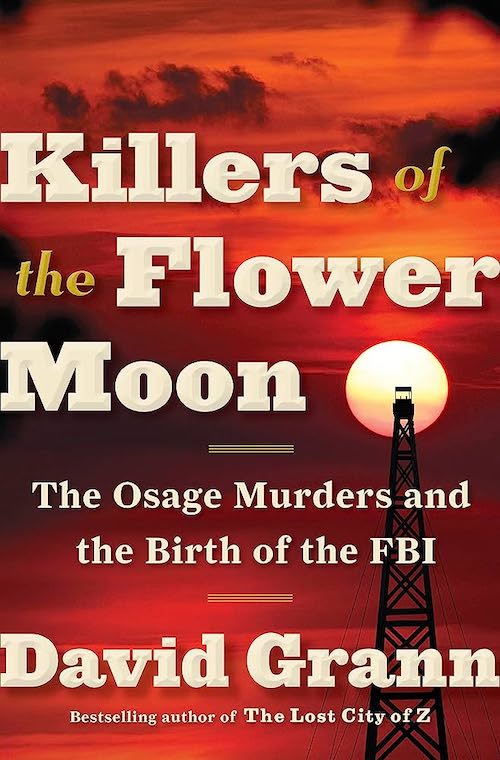Killers of the Flower Moon By David Grann
Reviewed by Michael Attard
The Osage Indians have a more than 2000-year history in North America, but I will start in 1803. In that year, U.S. President Thomas Jefferson purchased from the French the territory of Louisiana, which was about 828,000 square miles. It included Osage lands. Jefferson addressed the chiefs as “my children.” This was the first inauspicious sign of the unequal relationship. Over two decades, the Osage were pushed into a small area of southeastern Kansas. By 1870, they were expelled from there. Eventually, many Osage walked across the Kansas border into Oklahoma. They settled on land that “most whites regarded as broken, rocky, sterile, and utterly unfit for cultivation.” By 1877, there were virtually no more buffalo to hunt. Smallpox, acquired from pushy white settlers, did not make life any easier. How could things get any worse?
The Osage had maintained all mineral rights to their land. Suddenly, with the discovery of oil, the Osage were rich. Not everyone was pleased. At one of the oil lease auctions, a reporter summed up what many were thinking: “The Osage Indians are becoming so rich that something will have to be done about it.”
The book has a long list of characters, and the author, David Grann, has endeavored to simplify this very complicated intrigue by centering the story around an Osage woman by the name of Mollie Burkhart. It is May 1921, and Mollie’s sister, Anna, disappears, and is then found murdered, shot in the head. The law authorities were not that interested in investigating Anna’s murder. But people were becoming uneasy. About a week before, another Osage murder victim had been found. A local newspaper reported that the Osage man was “popular among both the whites and the members of his own tribe.”
Mollie turned to her husband’s uncle, William Hale, for help. Mollie had married Ernest Burkhart, a white man. His uncle William was well-respected and considered “Osage County’s greatest benefactor.” These two men would play important roles as the drama unfolded. Anna’s ex-husband, Oda Brown, is a suspect in Anna’s murder. Then Mollie and Anna’s mother suddenly dies. Mollie’s brother-in-law, Bill Smith, suspects foul play and that all of the deaths are connected. Yes, the reader needs to pay attention to the names and actions, as there are many more victims and suspects to follow.
Surrounding all the details is the central horror story. A headline in the Washington Post noted what seemed to be increasingly clear: CONSPIRACY BELIEVED TO KILL RICH INDIANS. Authorities, realizing that something was up, did not curtail the killers. In 1923, the Oklahoma state governor sent his top investigator. The investigator is soon murdered and thrown from a train. Whoever the killers are, they are spread out and well-entrenched.
To be clear, it is all about the Osage oil money. The white man’s racist and patriarchal views had established a guardian system for the Osage ripe with graft. Often declared incompetent, most Osage had a white man controlling their wealth. Any white man married to an Osage woman would inherit her wealth upon her death.
An additional interesting aspect of the book is that the author provides a lesson on the origins of the Federal Bureau of Investigation. In fact, it was the Osage murders which were the main impetus for the creation of the F.B.I. We meet Tom White, the F.B.I. agent eventually assigned to the case. His investigation was stymied by “the refusal of witnesses to cooperate because of prejudice, corruption, or, as an agent put it, an almost universal fear of being bumped off.” But this does not preclude White from determining a logical pattern to the deaths.
With white citizens refusing to implicate one of their own, Detective White turned to known outlaws. But this group, generally intent on saving their own skin, would lie or later recant any truth that they had told. The writer creates intense emotion for the reader through the exposition of the details regarding an eventual arrest, the trial proceedings, a hung jury, and much later on, a verdict. The reader is well aware of who the perpetrators of these egregious crimes are and, like the Osage, only partially, or perhaps even only minimally, satisfied with the verdict.
So-called justice only convicted and leniently sentenced the tip of the iceberg. “The jurors were willing to punish the men for killing an American Indian, but they would not hang them for it.” The story left me with a sense of disgust. For in that time and in that place, “there was a culture of killing.” Officially, there were twenty-four murders during the “Reign of Terror,” but it is believed that the actual death toll was in the scores if not hundreds. There was more than a single conspiracy. All walks of life were involved, even “doctors who falsified death certificates and undertakers who quickly and quietly buried bodies.”
In 2023, the movie Killers of the Flower Moon was released. It is directed by Martin Scorsese. Mollie Burkhart is played by Lily Gladstone, Ernest Burkhart by Leonardo DiCaprio, and William Hale by Robert De Niro.
The Reviewer
Michael Attard is a Canadian who has lived in Gwangju since 2004. Though officially retired, he still teaches a few private English classes. He enjoys reading all kinds of books and writes for fun. When the weather is nice, you may find him on a hiking trail.





